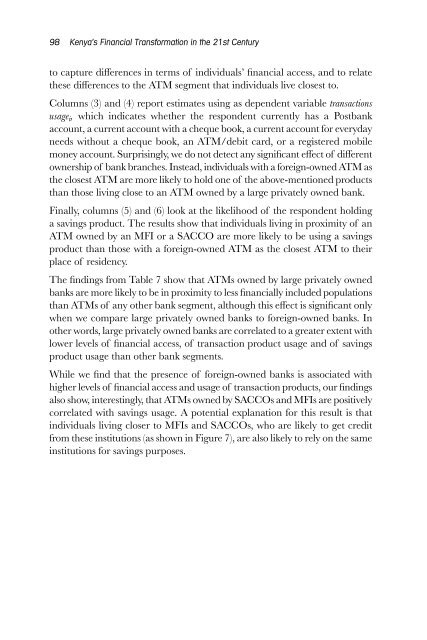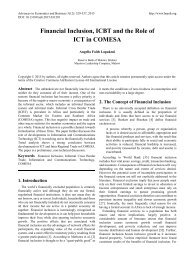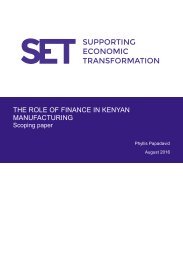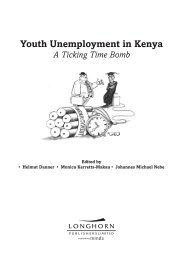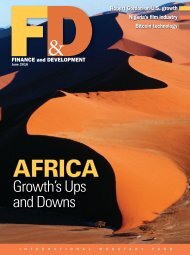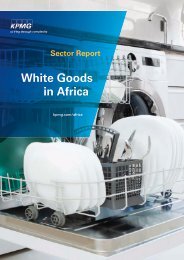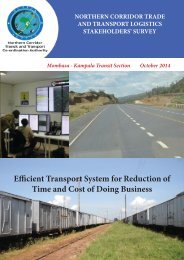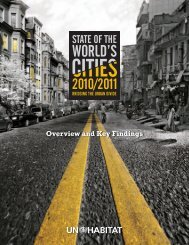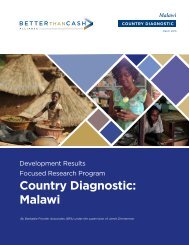in the 21st Century
hTOE305aYVW
hTOE305aYVW
You also want an ePaper? Increase the reach of your titles
YUMPU automatically turns print PDFs into web optimized ePapers that Google loves.
98 Kenya’s F<strong>in</strong>ancial Transformation <strong>in</strong> <strong>the</strong> <strong>21st</strong> <strong>Century</strong><br />
to capture differences <strong>in</strong> terms of <strong>in</strong>dividuals’ f<strong>in</strong>ancial access, and to relate<br />
<strong>the</strong>se differences to <strong>the</strong> ATM segment that <strong>in</strong>dividuals live closest to.<br />
Columns (3) and (4) report estimates us<strong>in</strong>g as dependent variable transactions<br />
usage i , which <strong>in</strong>dicates whe<strong>the</strong>r <strong>the</strong> respondent currently has a Postbank<br />
account, a current account with a cheque book, a current account for everyday<br />
needs without a cheque book, an ATM/debit card, or a registered mobile<br />
money account. Surpris<strong>in</strong>gly, we do not detect any significant effect of different<br />
ownership of bank branches. Instead, <strong>in</strong>dividuals with a foreign-owned ATM as<br />
<strong>the</strong> closest ATM are more likely to hold one of <strong>the</strong> above-mentioned products<br />
than those liv<strong>in</strong>g close to an ATM owned by a large privately owned bank.<br />
F<strong>in</strong>ally, columns (5) and (6) look at <strong>the</strong> likelihood of <strong>the</strong> respondent hold<strong>in</strong>g<br />
a sav<strong>in</strong>gs product. The results show that <strong>in</strong>dividuals liv<strong>in</strong>g <strong>in</strong> proximity of an<br />
ATM owned by an MFI or a SACCO are more likely to be us<strong>in</strong>g a sav<strong>in</strong>gs<br />
product than those with a foreign-owned ATM as <strong>the</strong> closest ATM to <strong>the</strong>ir<br />
place of residency.<br />
The f<strong>in</strong>d<strong>in</strong>gs from Table 7 show that ATMs owned by large privately owned<br />
banks are more likely to be <strong>in</strong> proximity to less f<strong>in</strong>ancially <strong>in</strong>cluded populations<br />
than ATMs of any o<strong>the</strong>r bank segment, although this effect is significant only<br />
when we compare large privately owned banks to foreign-owned banks. In<br />
o<strong>the</strong>r words, large privately owned banks are correlated to a greater extent with<br />
lower levels of f<strong>in</strong>ancial access, of transaction product usage and of sav<strong>in</strong>gs<br />
product usage than o<strong>the</strong>r bank segments.<br />
While we f<strong>in</strong>d that <strong>the</strong> presence of foreign-owned banks is associated with<br />
higher levels of f<strong>in</strong>ancial access and usage of transaction products, our f<strong>in</strong>d<strong>in</strong>gs<br />
also show, <strong>in</strong>terest<strong>in</strong>gly, that ATMs owned by SACCOs and MFIs are positively<br />
correlated with sav<strong>in</strong>gs usage. A potential explanation for this result is that<br />
<strong>in</strong>dividuals liv<strong>in</strong>g closer to MFIs and SACCOs, who are likely to get credit<br />
from <strong>the</strong>se <strong>in</strong>stitutions (as shown <strong>in</strong> Figure 7), are also likely to rely on <strong>the</strong> same<br />
<strong>in</strong>stitutions for sav<strong>in</strong>gs purposes.


